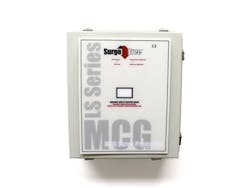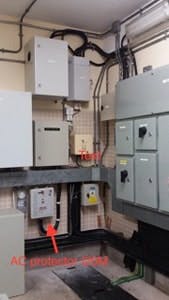Water Districts & Surge Protection
Motor control centers (MCCs) can be found in many places, including water districts (WD), wastewater treatment plants (WWTP) and other facilities that use similar infrastructure. Next to the pump motors themselves, the variable frequency drives (VFDs) employed in the MCC are the workhorses of any such facility. These electronic devices are connected in series with the pump motors in order to primarily provide precise motor speed and torque control. While VFDs are typically reliable, they do have an Achilles’ heel – they are susceptible to damage from over-voltages on the incoming AC power. The AC power feed to the VFDs is typically 600 VAC and less. Four hundred eighty-VAC, three-phase VFDs are very popular, as are 208- to 240-VAC, three-phase or single-phase VFDs.
The Solution
To prevent costly system downtime, a high-quality surge protective device (SPD) is installed upstream of the MCC (and the VFD within it) to limit any transient over-voltages to an amplitude that the VFD can handle without being damaged or disrupted. Though there are exceptions, a single SPD is often all that is required per MCC. Employment of these protectors has benefited a number of water districts, including South Farmingdale, N.Y., WD; Franklin Square, N.Y., WD; and Dix Hills, N.Y., WD. Preventing over-voltages due to lightning and utility issues from reaching the equipment has vastly improved uptime and plant reliability.
A protector’s job is to limit momentary over-voltages to safe levels. These over-voltages are caused by nearby lightning activity, utility switching transients and other sources. The protectors are connected in parallel to the load (the VFD), and, as a result, do not conduct load current. Once the protector’s positive or negative voltage threshold is reached, the protector “turns on” in nanoseconds and safely diverts the surge current through itself. (The term “turns on” means that the protector transitions from its standby mode – a virtual open circuit – to a very low resistance on the order of milli-ohms to conduct the surge current.) The surge protector becomes the most attractive pathway for the surge current. If a surge protector is not used, these over-voltages would constantly be impressed on the VFD, causing damage and degradation. Ultimately, they would cease to function.
MCG AC Power Line Protectors that have been successfully used in MCCs to protect VFDs are the 160M series, the LS series and the PT series. And except for the smallest models, all of these units employ protection redundancy – more than one fused surge path per phase. In critical sites, using a protector with more than one fused surge path per phase ensures that protection is maintained, even if a protection component is damaged and safely removed from the power line (via a thermal fuse or other means).
Modular MCG protectors (160M and LS models) allow for easy field repair, which minimizes any lapse of protection at the site should a partial failure occur inside of the protector. MCG modular units have a lifetime free replacement warranty on the field-replaceable protection modules and fuses. The protection modules and fuses are the heart of the MCG protector. On a daily basis, these devices are diverting harmful surge currents, so having a lifetime warranty on the heart of the surge protector means there will be no unpleasant expenses down the road.
A simple installation of a quality surge protective device keeps water districts and wastewater treatment plants up and running by preventing damage to equipment and downtime.

